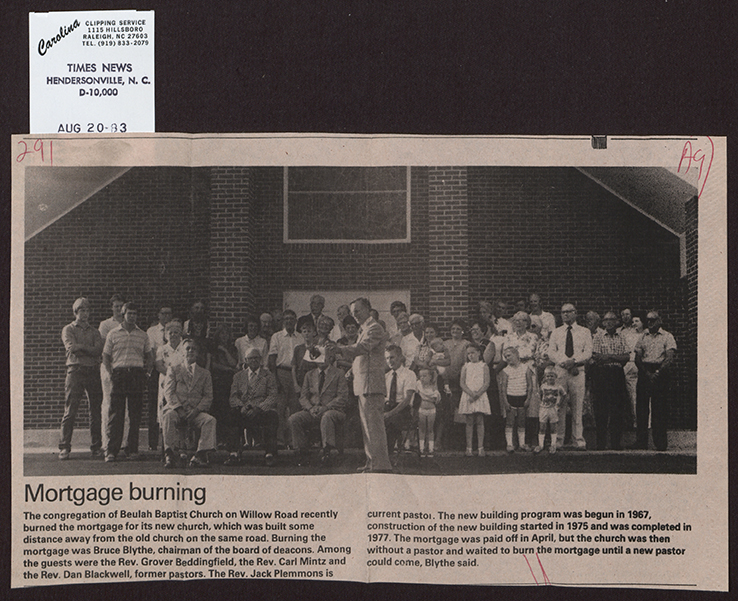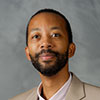Lasting approximately 8 years, it’s fair to say that the digitization of the NC Baptist Church and Association Files Collection has been a monumental project—turning thousands of historical records into a digital resource for researchers and the broader public.
We began digitization in late-2017 with the goal to preserve the rich history of over 7,300 churches and church associations across North Carolina and surrounding areas. The 193-box collection includes records dating back as early as the 18th century. This includes rare materials like handwritten notes, meeting minutes, church directories, and photographs. As one of our most used collections, the goal is to provide access to these key resources from anywhere with an internet connection, unlocking stories of faith, community, genealogy and more.

Documenting our progress
With the help of meeting minutes and past email messages, I attempted to create a general timeline of our journey:
2017: Our project kicked off in 2017, with digitization starting that September and the first uploads online that same year. Our earliest progress was documented in a blog post that October.
This project also coincided with another large scale project that kicked off the Spring of that year, the University Archives Photograph Collection. Digitization is also near completion with this project.
2018: By June 2018, 468 churches were online, and we reached Box 25. Student assistants also began assisting with metadata creation.
2019: By April 2019, around 1,875 folders were digitized, reaching Box 60. By the end of that year, we reached Box 73.
2020: Metadata from the online collection was harvested for the first time for inclusion to DPLA in January. The year 2020 also marked a year of adaptation, dealing with both technical and pandemic-related challenges. Digitization reached Box 83 in early 2020, but then digitization slowed to a halt as the COVID-19 pandemic reached the US. With COVID-19 restrictions, more focus was placed on uploading already digitized files and clearing out storage space on the lab computers.
That October we had begun relocating some of the physical boxes from ZSR to offsite storage, creating more space in the library for other physical collections to be housed.
2021: By August 2021, the project reached Box 126, and we continued to add files online.
2022: The project reached Box 136 by September.
2023: Significant uploads continued throughout the year, and digitization progressed to Box 175 by that September. There was also a focus on completing the remaining boxes and ensuring the completeness of earlier scans.
During the Spring 2024 semester, the digitization phase of the project was substantially concluded. However, there remain instances of churches or church associations that escaped attention during the digitization process—an inevitable hurdle when dealing with such a vast collection.
This is typically discovered as patrons request specific churches. In these cases, the physical folders are pulled from storage and digitized. This highlights the unpredictable nature digitization projects can have, and the challenges of digitizing large collections.
In total, we have digitized approximately 89,239 objects at a total storage size of 1.19 terabytes (TB).
The Heart of the Project
The process involved in digitizing this collection included the collaboration among Special Collections and Archives, DISC, student assistants, and our Tech Team. Moreso, the dedication of our student team has been the driving force behind this project’s success. A total of 13 current and former student assistants contributed: Cierra Bodrick (‘19), Manny Eggers (‘21), Ludan Gbaye (‘20), Kendall John (‘21), Jordan Hansgen (’17), Maryam Khanum (‘24), Labrini Panagopoulos, Ragan Price, Arisbeth Camarillo Reyes (‘22), Lexie Skeen (‘23), Kaylly Vazquez, Camryn Walker, and Nissa Walker.
Each student brought a unique perspective and energy to the work, scanning documents, creating metadata, and ensuring that each record was ready for ingest to our digital collections. In addition, Barry Davis, ZSR’s Multimedia & Digital Production Services Coordinator, continues to be our go-to for batch uploads of these files to our digital collections.

Challenges and Lessons Learned
Like any major digital project, our journey was not without setbacks. The most notable hurdle we encountered involved re-digitization of several overwritten files caused by naming conflicts. It was a valuable teaching moment for myself on how to train students regarding file-naming conventions.
In February 2020, a technical setback involved a power outage as electrical work was being completed in the processing room. We also had an issue with one of the two Zeutschel scanners, which required repairs. During this period, students worked primarily on metadata, as well as assisting with additional tasks in other SCA areas, particularly helping Stephanie Bennet with the inventory of a physical collection.
Looking Ahead
While we have reached a significant milestone, the work is far from over. Our focus now is on making sure every digitized file is online. Focus has also been shifted to transitioning the digitized files to our long-term storage platform.
Overall, digitization of the NC Baptist Church and Association Files Collection has definitely been a journey. This project has significantly shaped my perspective on managing large collections and the unpredictability of preserving it.

9 Comments on ‘From Boxes to Bytes: Digitizing the NC Baptist Church and Association Files Collection’
Thank you, Mel, and students, for working so diligently on this long-term project! Researchers use this collection nearly every day and it is such a great resource for anyone researching Baptist heritage. Congratulations!
What a tremendous job on an important project. I know this collection will be super valuable for the users who need access to these materials. Congratulations Melde.
Amazing work! Congratulations to you and your students!!
It must feel amazing to complete such a long-term project. Congrats to you and all your students who made this possible!
This is wonderful, Mel. This initiative makes unique content available to anyone who needs access to it. This is important work!
Many researchers will benefit tremendously from the results of this impressive work. Congratulations.
What a tremendous effort!! Thanks for sharing this work with us, Mel!
Such a fruitful and useful project, and amazing to see how many student workers contributed to the digitization as well as faculty and staff! What an accomplishment!!!!
It couldn’t have happened without you and your dedication to getting it right.